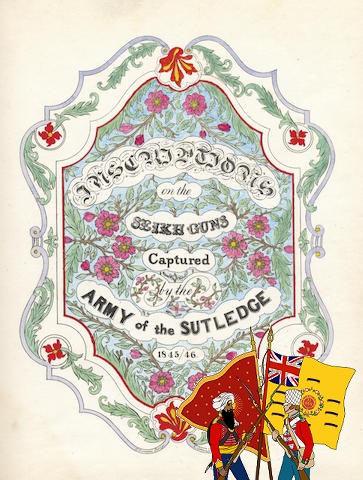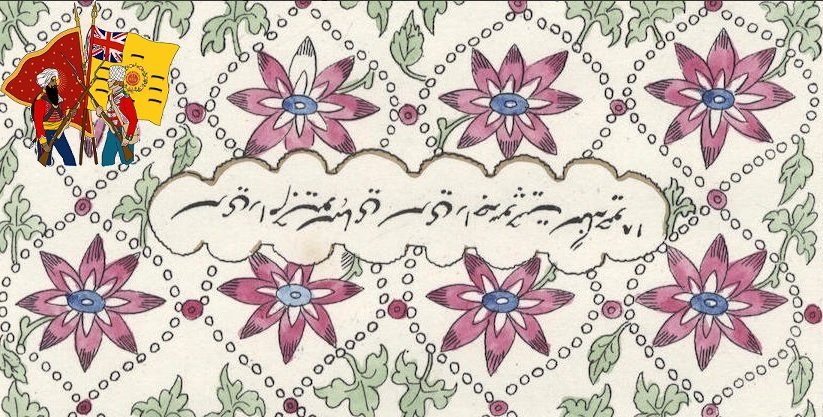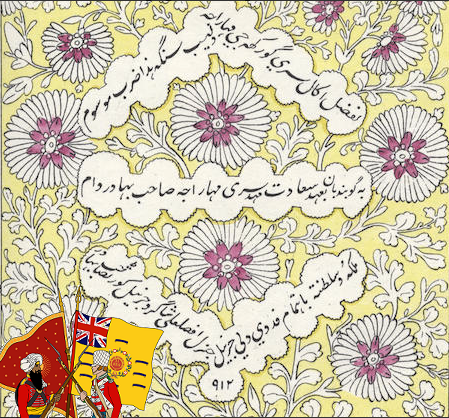
Inscriptions on the Seikh Guns Captured by the Army of the Sutledge 1845-46, FIRST EDITION, PRESENTATION COPY FROM SIR HUGH GOUGH, THE COMMANDER IN CHIEF OF THE INDIAN ARMY
Sold at Bonhams auction for £9,375 on 9th November 2016.
Inscriptions on the Seikh Guns Captured by the Army of the Sutledge 1845-46, FIRST EDITION, PRESENTATION COPY FROM SIR HUGH GOUGH, THE COMMANDER IN CHIEF OF THE INDIAN ARMY inscribed “Gough to his nephew J.B. Gough, Simla 9th Oct. [18]49”, 64 hand-coloured lithographed plates (including title signed “C. Gomeze, Script” and “C. Gomeze Lith.”, printed recto only), interleaved throughout, contemporary morocco gilt, covers with gilt roll-tool borders, enclosing on upper cover title “Inscriptions on the Captured Seikh Guns”, g.e., upper cover detached, small loss to head of spine, 4to (280 x 215mm.), [?Calcutta, c.1847-9]
FOOTNOTES
- SCARCE MEMENTO OF THE FIRST ANGLO-SIKH WAR, WITH A FINE PROVENANCE. COPAC cites only 2 copies (V&A and Bodleian), with another located at The National Army Museum. The title-page gives the name of “C. Gomeze” as the designer and lithographer – surely the “Christopher Gomez, of the H.C. Lithographic Press [Calcutta]” whose marriage is noted in The Asiatic Journal and Monthly Register for British and Foreign India (1835). Authorship has sometimes been attributed to Captain Ralph Smyth of the Bengal Artillery, whose extensive research into the mechanics of the guns was published as Plans of Ordnance Captured by the Army of the Sutledgec.1850. Each page has a different all-over design, mostly of a floral pattern, in which is incorporated a Persian inscription (mostly in Nastaliq script with some in Lahnda or Devanagari) taken from one of the Sikh guns captured by the British.

Symbols of Sikh military power, the canons were manufactured between 1801 and 1839 at the instigation of Maharaja Ranjit Singh, making the Sikh Khalsa Darbar Army the most modern army the East India Company ever faced in battle. The majority of the 256 guns that were captured during the conflict were melted down, however a few of the most ornate pieces were sent to Britain – some of which are still present in collections held by the Royal Arsenal, Woolwich; the Royal Hospital, Chelsea; and Dover Castle.

Provenance: John B. Gough (1804-1891), gifted to him by his uncle Hugh Gough, inscribed “Gough, to his nephew, J.B. Gough, Simla, 9th Oct. [18]49”, on front free endpaper. During the First Anglo-Sikh War J.B. Gough commanded the cavalry brigade during the Battle of Ferozeshah, whilst his uncle Hugh was chief commander of the British troops during both the First and Second Anglo-Sikh Wars. “The Sikh guns, firing from behind their field fortifications, could not be silenced. It was clear, as at Ferozeshah, that the battle could not be gained by superiority of artillery fire… This was reported to [General Sir Hugh Gough, who]… turning to his nephew, Colonel J. B. Gough, Quartermaster-General, directed him to convey the order [to advance with a bayonet attack]” (Charles Gough and A.D. Innes, The Sikhs and The Sikh Wars – The Rise, Conquest and Annexation of The Punjab State, 1897).
